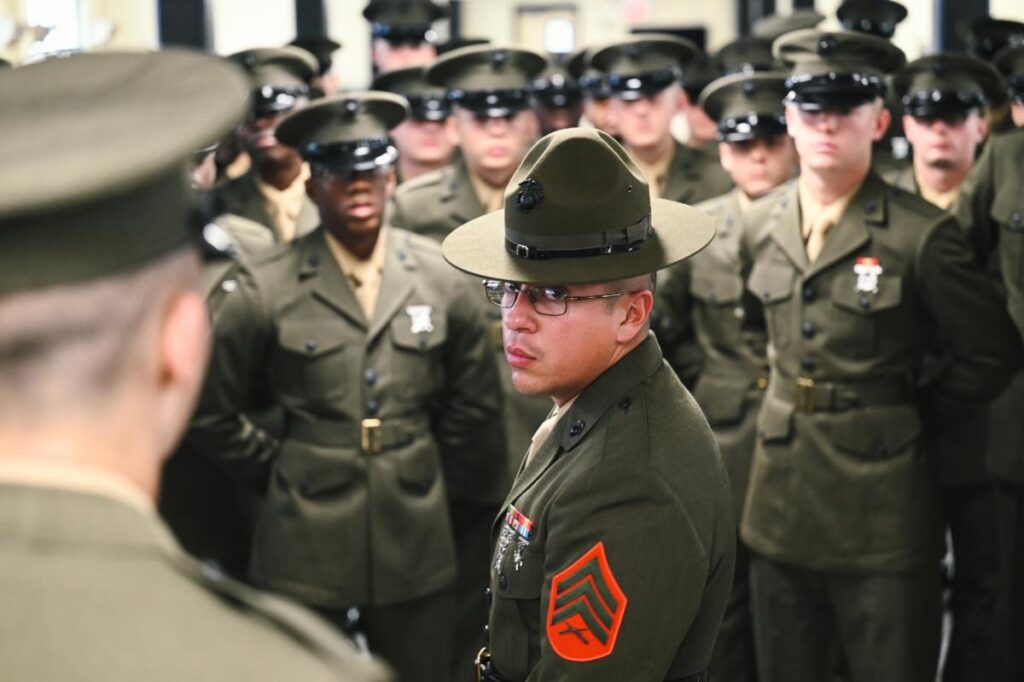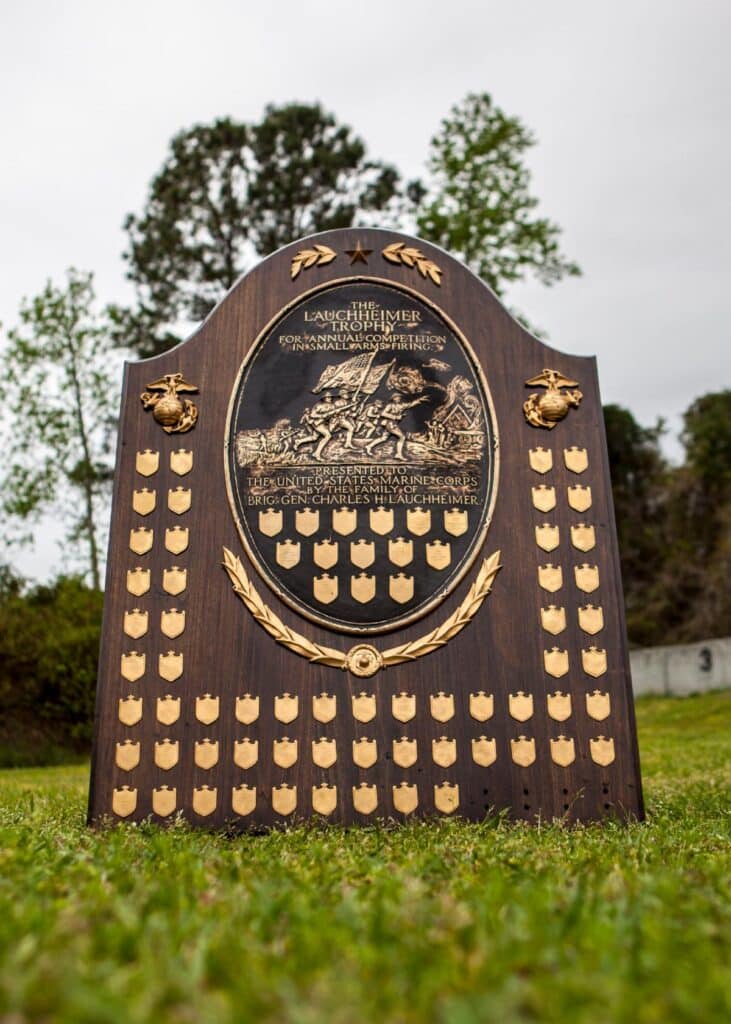Front and Center Newsletter – Vol. 2, No. 5, May 2024

Meet the Marine. Be Inspired.
FRONT AND CENTER
Vol. 2, No 5, May 2024
Mission
Honor, preserve, and teach the legacy of Carolina Marines and Sailors.
Showcase the Marine example to inspire future generations.
.
Message from the CE0
Dear Marines and Sailors, Friends and Family,
We are finalizing all plans for our Groundbreaking Ceremony on 17 May at 08:30. It is going to be a great day as we collectively celebrate the progress we have made together. We look forward to sharing this special day with you.
However, it is important to remember that it is just the beginning and there is still a long road ahead to opening day. Your continued support is even more important as we begin this next phase of our journey together.
There is a great quote that says, “A goal is a dream with a finish line” and our goal remains the same. We will do the following:
- Honor, preserve, and teach the legacy of Carolina Marines and Sailors.
- Showcase the Marine example to inspire future generations.
- Build and operate a Museum that all are proud of.
We must ensure that the contributions of Carolina Marines and Sailors to our Nation’s freedom are remembered and never forgotten.


BGen Kevin Stewart, USMC (Ret)
Chief Executive Officer

Marine Corps Traits and Principles of Leadership, Part VI
by James Danielson, PhD
Marine Veteran
Marine Corps recruits at Parris Island, South Carolina have the interesting experience of a pattern guiding the way drill instructors train them. In an ordinary day at that extraordinary place recruits will learn several skills. The pattern begins with one or more drill instructors explaining the task to the recruits and repeating themselves when necessary to ensure that the task is understood. Then, a drill instructor will perform the task so recruits can see it done correctly. When the recruits seek to execute correctly the task they’ve just learned, drill instructors supervise closely. In some cases, recruits don’t quite get it right, so the task is done again ensuring that it is understood by each recruit, since if the task is not understood, it will not be accomplished.
This pattern expresses the Marine Corps leadership principle of ensuring the task is understood, supervised, and accomplished. It is evident on even cursory examination that this principle has three elements. The first element, ensure the task is understood, requires communication. That communication is required is obvious, but it isn’t always obvious what communication means. First, communication can take various forms like semaphore, Morse code, hand signals, or writing, and like all forms of communication, these each have strengths and weaknesses. Of course, communication takes place under differing circumstances such as emergencies in which communication must take place without the benefit of questioning and answering. For this discussion, we will consider this leadership principle operating within the context of training or educating where the people involved are gathered together.

It is a commonplace assertion that not everyone is a good communicator. We meet people from time-to-time who know their field of study or practice extremely well but seem not to be able to explain things in ways that others readily grasp. Perhaps the most useful way to negotiate the difficulties created by unskillful explanations of things is for those being instructed to ask clarifying questions. Interestingly, an instructor who doesn’t communicate very well can improve by attending carefully to the questions he is asked, since these will indicate to the instructor how people misunderstand him. If we think of communicating using conversation as our example, one thing of importance stands out: listening. One might think that most people have had the experience of talking with a person who clearly isn’t listening. Whatever we might call this, it isn’t a conversation; communication, properly understood, isn’t happening because no understanding is taking place. In order for communication to happen, for understanding to emerge, people must listen. It seems correct to say that listening isn’t truly a passive act. Rather, a listener must focus in order to grasp the words being spoken, the speaker’s tone of voice, and facial and physical gestures. Reading, interestingly, is a form of listening but without the cues of tone of voice and gestures, which is why people in the ancient world held reading to be second best. One cannot ask questions of a book, and a reader doesn’t have the benefit of the teacher physically being present. Reportedly, if someone entered a library in a medieval university there would not be silence because students tended to read out loud in order to hear the words spoken.
When a leader is certain that he has been understood, the task must then be supervised to ensure it is accomplished correctly. Here we see the importance of knowing oneself and seeking self-improvement, and being technically and tactically proficient, the first two leadership principles, to ensuring a task is understood and to supervising it to successful completion. Here we might consider styles of supervision, but in general we can say that how to supervise a task will be determined by the task itself and the leader’s knowledge of the people he is supervising. It is said of our namesake here at the Al Gray Marine Leadership Forum, General Al Gray, that when leading other leaders, he would ensure that commander’s intent was understood and then trust the leaders to decide how best to accomplish it. When a leader would come to General Gray for advice about accomplishing a task, he would discuss various options and let the leader decide from there. The point is, of course, that there are different ways of supervising others, and we can reasonably say that it is as much art as science.
The leadership trait of tact is not one that recruits would readily associate with drill instructors. At “Marine OCS Blog” one finds tact defined this way: “Tact means that you can deal with people in a manner that will maintain good relations and avoid problems. It means that you are polite, calm, and firm.” Understanding tact in this way, it is clear that a leader who possesses the trait of tact will be more effective at ensuring understanding of a task and supervising it to successful completion. We may say that we all know what it is to be polite, but this definition of tact adds to politeness calmness and firmness. There are many possible situations in which either circumstances, people’s behavior, both, or unforeseen developments can incite in someone anger or frustration, but a tactful leader will control those feelings and not let them show. Moreover, a leader, or anyone, with a calm mind is much better able to think through problems and respond effectively than is someone struggling to shake off anger or irritation.
Firmness is not the same as stubbornness. Someone who is stubborn, for example, is unlikely to concede that he is wrong even when it is demonstrated. This is most undesirable because someone who is not able to see that he is wrong cannot learn. More important is that someone who is stubborn and wrong in any set of circumstances is likely to get himself and others hurt, or in any case, fail at a task. But a leader who will listen to the questions and observations of subordinates and consider them is in a much better position than is the stubborn fellow. Nevertheless, when a decision must be taken and executed, a tactful leader will possess the firmness of character to see that the moment of action has arrived and proceed with determination.
A leader who is determined to act justly, is possessed of sound judgment, is dependable, takes initiative, and is decisive will surely be tactful, and will be able effectively to make each task understood by those who will perform it, and to guide them to successful accomplishment of whatever tasks are assigned.
Brigadier General Charles Lauchheimer and the Lauchheimer Trophy

Copyright Owner: Naval History and Heritage Command

The Lauchheimer Trophy is displayed during the 2015 U.S. Marine Corps Matches on Stone Bay Rifle Range, Camp Lejeune, N.C., April 16, 2015.
The Lauchheimer Trophy is awarded to the competitor attaining the highest aggregate score in the individual rifle and pistol competitions. (U.S. Marine Corps photo by Lance Cpl. Jacqueline R. Smith, MCI-East Combat Camera/Released)
On March 15, 2024, Leatherneck Magazine published an article by Col Dwight H. Sullivan titled “The Life of Lauchheimer: The Man Behind the Corps’ Top Shooting Trophy.” In the article, Col Sullivan discusses the remarkable career of BGen Charles Lauchheimer and how the trophy bearing his name came about. In what follows, we will survey the salient elements of this article.
Charles Lauchheimer was born in Baltimore, Maryland on September 22, 1859 to Meyer and Babeth Lauchheimer. He was the fifth of nine children. Lauchheimer graduated from a public secondary school, called Baltimore City College, in June of 1877.
That year, Baltimore Congressman Thomas Swann held competitive examinations to select his nominee to the Naval Academy. The six candidates all had graduated from Baltimore City College, and Lauchheimer won the contest.
At the Naval Academy, Lauchheimer did well, graduating in 1881 in the top fourth of his class. The young midshipman was well liked and was something of a prankster. In his second year at the Academy, Lauchheimer and several other midshipmen were confined to the yard at the school for disciplinary violations with the result that they could not go on liberty on a Saturday afternoon. Lauchheimer and his fellow inmates sewed bedsheets together to make a large banner on which they wrote: “Give us liberty or give us death.” The midshipmen placed the banner in front of their barracks facing the quarters of the superintendent.
When Lauchheimer attended the Naval Academy, the program lasted six years, the last two of which were spent at sea. So the students completed their formal studies in four years, went to sea for two years, then returned to the Naval Academy for a final examination. Because of restrictions on the Navy at that time, there were only 23 commissions available for the 86 students taking the exam. Lauchheimer scored 14th in his class, and requested one of ten commissions available in the Marine Corps. With this commission, Lauchheimer and nine others became the first Naval Academy graduates to receive commissions in the Marine Corps.
Lauchheimer served for a time on naval vessels, and in March of 1892 he was assigned to the office of the Judge Advocate General of the Navy. In October of 1892, Lauchheimer enrolled in what today is George Washington Law School for a two-year course leading to the degree of Bachelor of Laws. Classes were held in the evening, so Lauchheimer could continue working in the JAG office in what today is the Eisenhower Executive Office Building. As a judge advocate, Lauchheimer excelled, receiving significant notoriety. Lauchheimer delivered popular lectures at the Naval War College, which lectures were published in Proceedings, a journal of the U.S. Naval Institute.
Beginning in 1899, Lauchheimer went through a rapid rise advancing from first lieutenant to colonel in six years. In February of 1899, Lauchheimer was promoted to captain. The next month, on March 3, the Senate approved Lauchheimer’s nomination to be assistant adjutant and inspector of the Marine Corps at the rank of major. In that office, Lauchheimer served, among other duties, as Inspector of Target Practice of the Marine Corps. In 1901, Major Lauchheimer entered a Marine Corps team in an international rifle competition in Sea Girt, NJ. The Marines finished sixth out of eleven teams, and Lauchheimer was underway improving Marine Corps marksmanship.
On March 23, 1903, Lauchheimer was promoted to lieutenant colonel and was required to transfer his duties as Inspector of Target Practice to a junior officer. Lauchheimer was sent to Manila to establish the office of Adjutant and Inspector of the Marine Corps in the Far East. He returned to Washington in December of 1904, was promoted to colonel, and became Adjutant and Inspector of the Marine Corps. However, Col Lauchheimer hit an obstacle in 1910 when he became involved in a number of disputes with the Commandant, Major General George Elliot. There was a court of inquiry concerning this situation, and Lauchheimer was transferred to Manila, while the Commandant served out the remainder of his term. However, Lauchheimer had loyal friends in the United States and in 1912, President Taft gave in to pressure and restored Lauchheimer as Adjutant and Inspector of the Marine Corps. The next year, the Army and Navy Club of Washington elected him as its president. A month later, Lauchheimer’s friend and Naval Academy classmate, George Barnett, became the 12th Commandant of the Marine Corps.
Following the sinking of the RMS Lusitania in 1916, President Wilson sought to expand the Navy through the Naval Act of 1916. Importantly for Lauchheimer, the legislation created seven new brigadier general billets for the Marine Corps, one of which was the senior officer in the Adjutant and Inspector’s department. The president nominated Lauchheimer, and the Senate quickly confirmed the nomination, making BGen Charles Lauchheimer the first Jewish general officer in the Marine Corps. Lauchheimer performed an important service for the Marine Corps as it expanded in preparation for WWI. The Marine Corps declined to accept draftees, preferring instead to maximize the quality of recruits. The recruiting program that Lauchheimer oversaw received 239, 274 applications for 60, 189 openings.
In July 1919, during an inspection tour on the west coast, Lauchheimer suffered a stroke that left him in a coma. Another stroke on July 14, 1920, killed Lauchheimer at 59 years old. Lauchheimer’s family sought to establish a shooting medal in his honor. The Commandant, Major General Barnett, endorsed the idea saying in part that Lauchheimer “was instrumental in establishing the present system of target practice in the Marine Corps which has placed the Corps, as you know, in the first ranks of shooters of the United States today.” When John A. Lejeune succeeded Barnett as Commandant, he saw that the goal of a Marine Corps shooting medal in Lauchheimer’s honor became reality. When Lauchheimer’s family presented to the Commandant the trophy for winning “The Lauchheimer Trophy for Annual Competition in Small Arms Firing,” Gen. Lejeune said: “…the distinguished services rendered by your brother, the late Brigadier-General Charles H. Lauchheimer, will forever enhance its value for every Marine.”
The first competition was held in 1921, and since then, the original brass plaque has been remounted twice to accommodate the growing number of names of annual winners, and the trophy also honors “Charles H. Lauchheimer’s role in developing Marines’ marksmanship prowess.”
General Al Gray’s 95th birthday guests stopped by to talk about their experiences with the 29th Commandant over his many years of service to this nation. We continue this series in honor and memory of Al Gray, Marine.
Below, Medal of Honor recipient, MajGen Jim Livingston, USMC (Ret) was among the stars who attended.
(See all of the interviews celebrating General Gray and his legacy at General Al Gray’s 95th Birthday.)

14 June 2024 Bear Trail Golf Club
Tee time 09:00
Click here for more information and to register now!
Please join us in supporting the mission of
Carolina Museum of the Marine.
When you give to our annual campaign, you help to ensure that operations continue during construction and when the doors open!
Stand with us
as we stand up the Museum!
Copyright May 2024. Carolina Museum of the Marine
2023-2024 Board of Directors
Executive Committee
LtGen Mark Faulkner, USMC (Ret) – Chair
Col Bob Love, USMC (Ret) – Vice Chair
CAPT Pat Alford, USN (Ret) – Treasurer
Mr. Mark Cramer, JD – Secretary
In Memoriam: General Al Gray, USMC (Ret)
MajGen Jim Kessler, USMC (Ret)
Col Grant Sparks, USMC (Ret)
BGen Kevin Stewart, USMC (Ret), CEO, Ex Officio Board Member
Members
Col Joe Atkins, USAF (Ret)
Mr. Mike Bogdahn, US Marine Corps Veteran
Mr. Keith Byrd, US Marine Corps Veteran
MGySgt Osceola “Oats” Elliss, USMC (Ret)
Mr. Frank Guidara, US Army Veteran
Col Chuck Geiger, USMC (Ret)
Col Bruce Gombar, USMC (Ret)
LtCol Lynn “Kim” Kimball, USMC (Ret)
CWO4 Richard McIntosh, USMC (Ret)
The Honorable Robert Sander, Former Counsel of the Navy
LtGen Gary S. McKissock, USMC (Ret)
Col John B. Sollis, USMC (Ret)
GySgt Forest Spencer, USMC (Ret)
Staff
BGen Kevin Stewart, USMC (Ret), Chief Executive Officer
Ashley Danielson, Civilian, VP of Development
SgtMaj Steven Lunsford, USMC (Ret), Operations Director
CWO5 Lisa Potts, USMC (Ret). Curator


